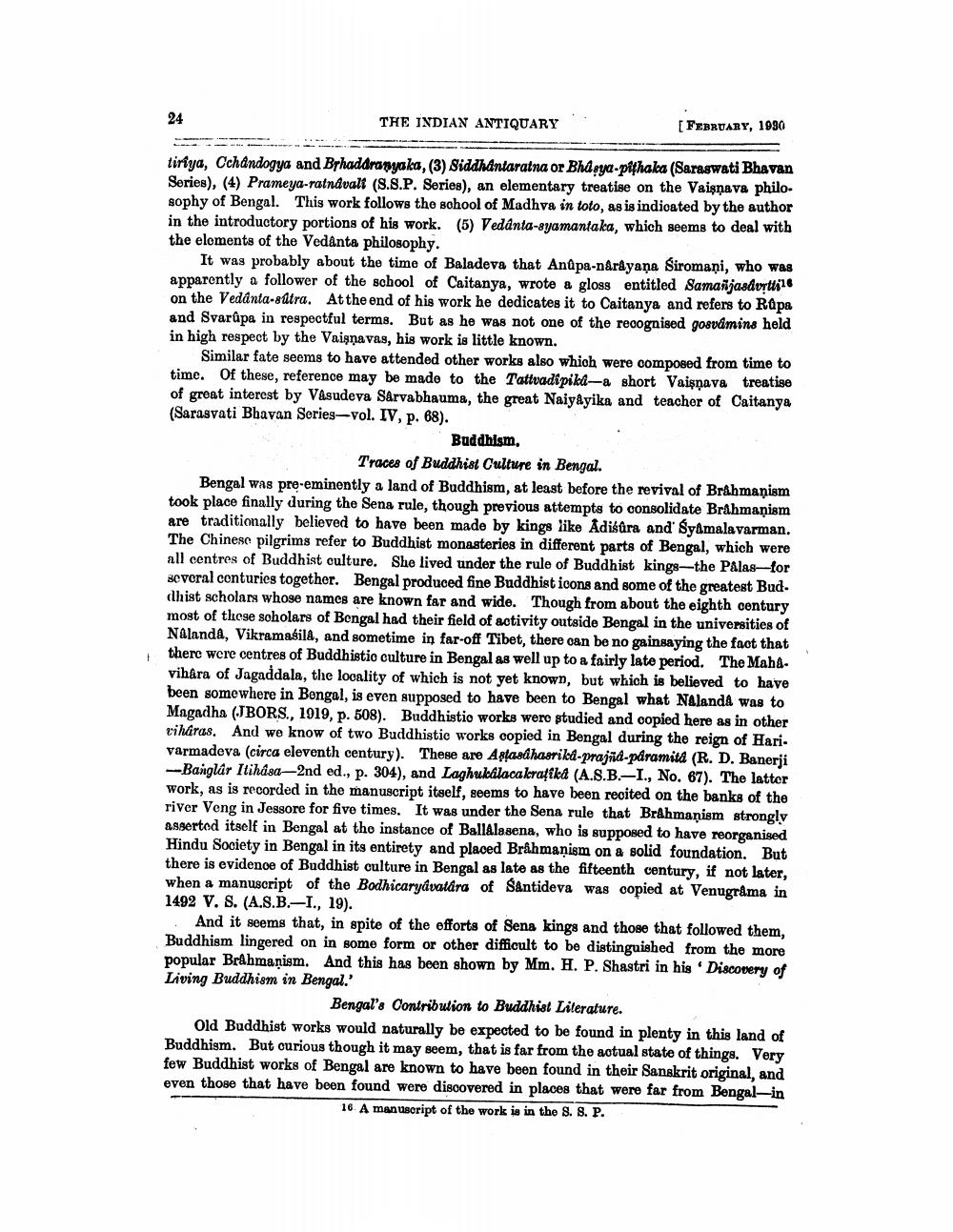________________
THE INDIAN ANTIQUARY
[FEBRUARY, 1990
tiriya, Cchandogya and Brhaddraryaka, (3) Siddhantaratna or Bhasya-pithaka (Saraswati Bhavan Series), (4) Prameya-ratndvalt (8.8.P. Series), an elementary treatise on the Vaisnava philosophy of Bengal. This work follows the school of Madhva in toto, as is indioated by the author in the introductory portions of his work. (5) Vedanta-ayamantaka, which seems to deal with the elements of the Vedanta philosophy.
It was probably about the time of Baladeva that Anapa-narayana Siromani, who was apparently a follower of the school of Caitanya, wrote a gloss entitled Samanjasdvrtlile on the Vedanta-sútra. At the end of his work he dedicates it to Caitanya and refers to Ropa and Svarûpa in respectful terms. But as he was not one of the recognised gosvámins held in high respect by the Vairnavas, his work is little known.
Similar fate seems to have attended other works also which were composed from time to time. Of these, reference may be made to the Tattvadipika-& short Vaisnava treatise of great interest by Vasudeva Sarvabhauma, the great NaiyAyika and teacher of Caitanya (Sarasvati Bhavan Series-vol. IV, p. 68).
Buddhism,
Traces of Buddhist Culture in Bengal. Bengal was pre-eminently a land of Buddhism, at least before the revival of Brahmanism took place finally during the Sena rule, though previous attempts to consolidate Brahmanism are traditionally believed to have been made by kings like Adiśûra and Syamalavarman. The Chinese pilgrims refer to Buddhist monasteries in different parts of Bengal, which were all centres of Buddhist culture. She lived under the rule of Buddhist kings-the PAlas-for several centuries together. Bengal produced fine Buddhist icons and some of the greatest Bud. dhist scholars whose names are known far and wide. Though from about the eighth century most of these scholars of Bengal had their field of activity outside Bengal in the universities of Nalanda, Vikramasila, and sometime in far-off Tibet, there can be no gainsaying the fact that there were centres of Buddhistio culture in Bengal as well up to a fairly late period. The Mah. vihara of Jagaddala, the loonlity of which is not yet known, but which is believed to have been somewhere in Bengal, is even supposed to have been to Bengal what Nalanda was to Magadha (JBORS., 1919, p. 508). Buddhistio works were studied and copied here as in other riharas. And we know of two Buddhistic works copied in Bengal during the reign of Hari. varmadeva (circa eleventh century). These are Asfasáhasrikd-prajíd-paramita (R. D. Banerji -Banglár Itihasa-2nd ed., p. 304), and Laghukalacakrafika (A.S.B.-I., No. 67). The latter work, as is recorded in the manuscript itself, seems to have been recited on the banks of the river Veng in Jessore for five times. It was under the Sena rule that Brahmanism strongly asgertod itself in Bengal at the instance of BallAlasena, who is supposed to have reorganised Hindu Society in Bengal in its entirety and placed Brahmanism on a solid foundation. But there is evidenoe of Buddhist culture in Bengal as late as the fifteenth century, if not later, when a manuscript of the Bodhicaryávatára of Santideva was copied at Venugráma in 1492 V. S. (A.S.B.-I., 19).
And it seems that, in spite of the efforts of Sena kings and those that followed them. Buddhism lingered on in some form or other difficult to be distinguished from the more popular Brahmanism. And this has been shown by Mm. H. P. Shastri in his Discovery of Living Buddhism in Bengal.'
Bengal's Contribution to Buddhist Literature. Old Buddhist works would naturally be expected to be found in plenty in this land of Buddhism. But curious though it may seem, that is far from the actual state of things. Very few Buddhist works of Bengal are known to have been found in their Sanskrit original, and even those that have been found were discovered in places that were far from Bengal-in
16 A manuscript of the work is in the S. S. P.




